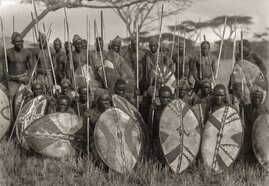They include
The Abaluhyia community is made up of eighteen sub-groups. The sub-groups which constitute the community have a common background, common customs and speak closely related dialects of the same language.
According to Abaluhyia tradition, communities used to hold criminal tribunals at the junctions of footpaths. The area at the junction of footpaths was known as Uluyia or a meeting point and it is claimed that the name Abaluhyia is derived from this. Another version states that in a polygamous home the courtyard outside the main father’s house is called Luhyia. All the children are referred as children of one Luhyia and hence the name Abaluhyia. Most of the Luhyia sub-groups point to mt. elgon dispersal point as their origin. The settlement of the Abaluhyia into Kenya dates back to 300 AD. By 1750 AD, many groups had settled in present day Bukhayo, Marama, Tiriki, Bunyore, Wanga and Maragoli. They absorbed some groups they found in the area. Also, their interaction with the Maasai led to establishment of clans like the Abashimuli among the Idakho. The Marachi, Kisa and Samia interacted with the Luo.
Abagusii traditions acknowledge a close relationship with the following people: the Abakuria, Abalogoli, Ababukusu, Abasuba, Agikuyu, Ameru, Aembu, Ambeere and the Akamba. Their tradition has it that on their way from the country which they call ‘Msiri’ they were accompanied by the Baganda and the Basoga besides the above groups.
The Abagusii and the Abalogoli migrated southwards following the River Nzoia valley and arrived near Lake Victoria between 1490 and 1520. Following an easterly course along the lake shore, they settled at the head of Goye Bay in Yimbo location of Nyanza with their homeland spreading across present day Ulowa, Sare and Unyejra at the foot of Ramogi hill. Luo migrants in 1550 AD found them settled in this general area and pushed them from alego to Kisumu where they lived upto 1600AD. Their migration from Kisumu to Kano was motivated by drought in the area.. However, their eastward migration was checked by the Maasai and the Kipsigis By the 18th century, they had settled in the Kisii highlands positively interacting with the neighbouring Luo, Maasai and Kipsigis in terms of trade. Why the Abagusii remained in the Kano plains for too long before settling in the Kisii highlands.
The origin of the name ‘Kuria’ is a thorny point in the Abakuria history. The major Abakuria sub-tribes such as Abanyabasi, Abatimbaru, Abanyamongo, Abakira, Abairegi and Abagumbe have traditions to the effect that their ancestor was Mokuria (or Mukuria) that lived in “Msiri”. His descendants migrated from “Msiri” and after many years of wandering on the other side of Lake Victoria; they eventually reached and settled in the present Bukuria By 1800AD, (in south Nyanza.)
According to this tradition, the Abakuria have been divided from time immemorial into two families: the Abasai of the elder wife of Mokuria and the Abachuma of the younger wife. The Abakuria are related to Abalogoli of Abaluhyia and Abagusii and trace same origin at mt. elgon dispersal point. The Abakuria people appear to have sprung from too many directions to have a common historical origin, although a number of clans claim to have come from Msiri. Among the Abakuria today are found people who were originally from Kalenjin, Maasai, Bantu and Luo speaking communities. The Abakuria adopted the practice of age set organization and circumcision from the southern Cushites
The name “Suba” means “the people who are always wandering”.
The Suba migrated into their current locations beginning in the mid-1700s. They came from the region just west of Lake Victoria and settled on the islands. The Suba migrated from Uganda and settled on the two Lake Victoria islands of Rusinga and Mfangano, and are believed to be the last tribe to have settled in Kenya. Other subgroups migrated and settled on the shores of Lake Victoria in the early 18th century. The Suba are descendants of one wave of the Bantu migration from Central Africa over the last 1500 to 1800 years. In the 16th century, it appears, small family groups related to the Ganda people on the western side of the lake migrated across Lake Victoria on boats to settle on Rusinga Island and other islands near what is now Kenya and Tanzania. The Suba are descendants of one wave of the Bantu migration from Central Africa over the last 1500 to 1800 years. In the 16th century, it appears, small family groups related to the Ganda people on the western side of the lake migrated across Lake Victoria on boats to settle on Rusinga Island and other islands near what is now Kenya and Tanzania. Linguistically, the Suba are highly influenced by the neighbouring Luo, to the point of a language shift having taken place among large portions of the mainland Suba. The remaining speakers of the Suba language are mostly elderly residents on the island of Mfangano. Related Topics
0 Comments
Leave a Reply. |
Archives
April 2024
Categories
All
|
Can't find what you are looking for? Don't worry, Use the Search Box Below.
|
Primary Resources
College Resources
|
Secondary Resources
|
Contact Us
Manyam Franchise
P.O Box 1189 - 40200 Kisii Tel: 0728 450 424 Tel: 0738 619 279 E-mail - sales@manyamfranchise.com |

 RSS Feed
RSS Feed

